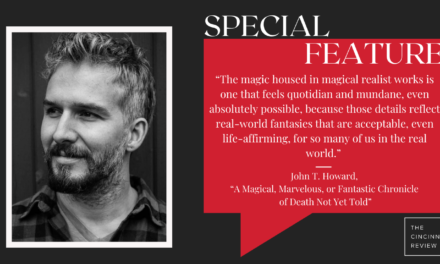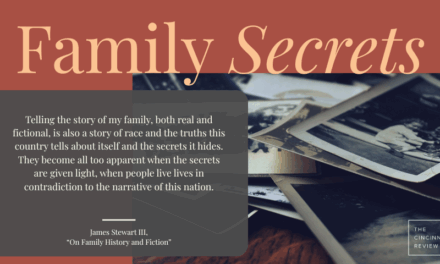Assistant Editor Lily Meyer: As a kid, I was terrified of ghost stories. I never made it more than a chapter into R. L. Stine’s horror-for-children Goosebumps series. Even Dr. Seuss’s What Was I Scared Of?, with its sweet message of friendship and tolerance, gave me the creeps.
As an adult, I am, frankly, little better. I am comically easy to scare, which, generally, means I stay away from all things spooky and ghostly. Still, Ellen Rhudy’s elegantly haunted “The Story You Want, the Story You Need” captivated me. Reading it reminded me that all ghost stories, at their hearts, are stories of grief and longing, and that the Halloween season is not only one of candy and jump-scares but of paying our respects to the dead.
To hear Ellen read her story, click below:
The Story You Want, the Story You Need
On the final day of her wedding, Ardita looks for signs of Saranda. A mouthful of dirt deposited on a step—there; the swish of a grave-crusted dress around a corner—there. She has done an awful thing, marrying the husband of her dead friend, and she waits for the costs to be made clear.
That there could be no cost, that they will dance the oro, and eat cake, and fall asleep in each other’s aching arms, is not a fact she could have imagined. That they could be happy.
***
Here is a story: A girl who is beautiful and kind marries a man, also beautiful and kind. Within a year she dies, her body knotted within itself. A death that seems impossible even to the doctors, who can only name the girl’s unbecoming a sort of miracle in reverse. A thing that should not have happened yet did.
Here is how the story continues: A second girl, not so good, not so kind, marries the husband of the first girl. Before the first girl is even cool in her grave, the wedding photographs have been replaced. The second girl finds a chill hand gripping her own as she walks through town. She finds a worm-bitten face inspecting her as she sleeps, breath catching, next to the first girl’s husband. She welcomes the first girl to her home, both of them dressed in their wedding gowns, and watches as tar-like coffee spreads down the chest of the first girl, who is struggling to swallow. She reaches out; she wipes away the stain.
***
Her husband’s name is Ardit. Ardit and Ardita. Here is a match even better than the first, the families agree, though only in private.
For the month after the wedding, Ardita dresses in her gown again and again to visit neighbors and family. She scrubs dishes in the courtyard and helps to prepare meals for the family, always with an eye on the gate for potential guests. At night she tries not to feel the weight of Saranda’s body pressed into the mattress beneath her.
One day Ardit holds her hand and says he can tell there is something she is hiding from him. I’m a perceptive man, he tells her. But when Ardita tries to tell him—how she and Saranda used to stack Rummikub tiles into tiny houses; and how they threw balls to freeze each other in this moment, or this one, or this one; and how they said they would marry on the same day and share a party, before they were old enough to know better; and how she watches for Saranda every night, hopes for her even—his forehead knots, tighter and tighter.
We should go to Italy, he says. I have my work. It’s time to get back.
***
Here is a story: How a girl takes her friend’s body, her putrid flesh and clacking bones, and folds them into a suitcase bound for Trieste. How she dyes her hair black, the way her friend’s was, and dabs her friend’s old lipsticks over her mouth. How she keeps the dresses, the shoes, the underwear from that first wedding and makes them her own. Ankles dripping blood into too-tight heels, toes blooming fresh blisters. How one day a stranger will visit their home, look at a photograph from her husband’s first wedding, and tell the girl, You were so beautiful that day.
Here is how the story continues: The girl will smile and take the photograph back. She will not correct the stranger. She will thank him and feel bones settle into bones and breath into breath. She will feel how two girls can become one.
***
The day they go, it is warm; the sun is bright. Ardita’s fifty-euro bus ticket loses its ink clasped in her sweating fist. Ardit allows her the window seat, and she watches the stilled waters as they cross the narrow bridge over the River Radika, imagines the lurch and plummet of their bus. Another story there. But they continue through Mavrovo Park, and then to the bus stations in Gostivar, Tetova, Shkup, where she pays ten denars to squat over a toilet bowl missing its seat.
At the border crossing to Serbia, the driver’s assistant collects their passports and carries them to the guard booth. Thick patters of rain stain the pavement. Ardita rests her head on the window. She watches for Saranda in their wake: the whish of her sodden skirts, the pitter of her mud-splattered footprints. She watches for any sign that her friend will follow them, and she finds there are none, not in this story. Still she watches the road unspool beneath them, forehead oily on the cool window. She waits for her story to become something else, something more like the one she deserves—something other than this man, his hand on her knee, his sleeping breath on her neck, and all the countries ready to spill before them.
Writer’s Statement: This story has lived so many lives over the past four years; while I always had a sense for the relationships at its core (the two women, the marriage), the contours of the world I placed them in were constantly shifting. I gave the story six thousand words, I moved it backward through time, I pulled it into pieces and put it back together more times than I want to recall, but nothing worked until I realized the story’s core was not just the friendship between Saranda and Ardita but the stories Ardita told herself about this friendship. Once I understood this haunting as something Ardita had created, an expression of her own guilt and grief, the story finally clicked into place.
Ellen Rhudy lives in Columbus, where she’s an MFA candidate at Ohio State and a fiction editor of The Journal. Her fiction has appeared in journals including Story, Uncharted Magazine, Split Lip, and Cream City Review. She recently completed a story collection and is working on a novel.











